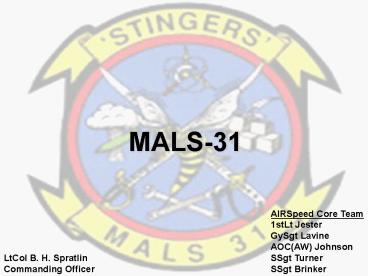MALS31 - PowerPoint PPT Presentation
1 / 13
Title:
MALS31
Description:
MALS-31. AIRSpeed Core Team. 1stLt Jester. GySgt Lavine. AOC(AW) Johnson. SSgt Turner. SSgt Brinker ... Improvements to the metric equate to improvements to the ... – PowerPoint PPT presentation
Number of Views:25
Avg rating:3.0/5.0
Title: MALS31
1
MALS-31
AIRSpeed Core Team 1stLt Jester GySgt
Lavine AOC(AW) Johnson SSgt Turner SSgt Brinker
LtCol B. H. Spratlin Commanding Officer
2
Measurement System Variability
3
Chart Captured in April 2006
Chart Captured in Oct 2006
4
Data Captured July 2006
Data Captured October 2006
5
(No Transcript)
6
Metrics
7
Bottom Line Metrics
- Advantages
- Improvements to the metric equate to improvements
to the bottom line. - The organization is focused on delivering
products that meet customer CTQs. - Disadvantages
- Numerous noise factors exist that can unduly
influence the bottom line metric (ex. phase
maintenance O-level Maintenance practices). - Due to noise, local (I-level) improvements may
not translate to bottom-line improvements. - As the I-level component to readiness improves
the need for O-level to skew readiness data is
reduced.
8
Using Intermediate Metrics
- In what respects is the I-level responsible for
flight line readiness? - Do opportunities exist to utilize intermediate
metrics that contain fewer noise factors? - Can assumptions be made about the impact of
intermediate factors upon the bottom line
building a case to monitor what we (near) fully
control?
9
Training
10
Variation in Length and Quality of Indoctrination
Training Exists
- MALS 31 utilizes a seven hour training program
to educate/indoctrinate members to AIRSpeed
practices. - MALS -14 utilizes a multi-day training program.
- Other sites utilize a single DAU course.
- Productivity Improvement Awareness (30 min)
11
Impact
- No minimum training standard exists across the
enterprise. - Significant differences in the level of
understanding and comprehension of AIRSpeed
principles exists.
Opportunity for Improvement
- Standardize training expectations
- Structure training around a agreed upon published
body knowledge. - Require training utilizing numerous medium (DAU,
NKO, lecture method)
12
MALS -31 Way Ahead
13
MALS-31 AIRSpeed Nov 2006 April 2007
AIRSpeed Indoctrination
Wave 3
SRD
KE 20-25
Wave II 60
SRD PDK
AIRSpeed Implementation
Wave III 30
Lean (Kaizen)
KE 20-25
Training Classes
Wave 4
Inspections
AGI TOC
Tollgate Review
TBD
TBD
LSSGB
Nov Dec Jan Feb Mar
Apr































